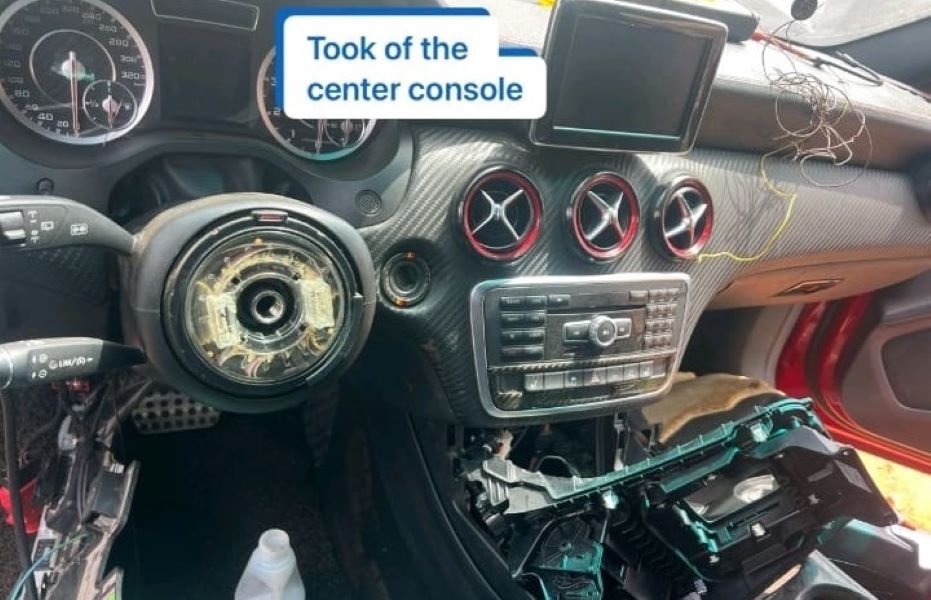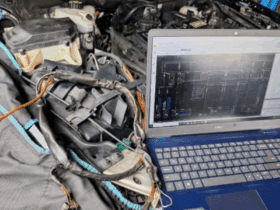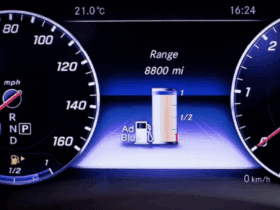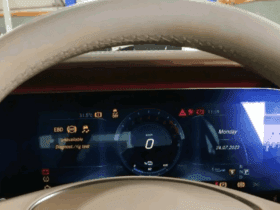Table of Contents
Transmission Slip Into Neutral While Driving: Causes, Diagnosis & Fix
A sudden slip into Neutral while driving is one of the most alarming transmission faults a Mercedes owner can face. Power drops to zero, engine revs flare, and safety is at risk especially in a performance car like the A45 AMG (W176, M133) with the 7-speed dual-clutch transmission (DCT).

Case Snapshot
| Vehicle | Powertrain | Complaint | Risk |
|---|---|---|---|
| Mercedes-Benz A45 AMG (W176) | M133 + 7-speed DCT | “Transmission slips into Neutral while driving” | Loss of drive, unsafe overtakes, gearbox damage if ignored |
What went wrong previously: A quick adaptation was attempted without a full diagnosis; later the TCU was replaced elsewhere, but the problem remained.

Symptom Explained
While cruising or accelerating, the car drops into N for a moment or stays there. No mechanical “bang,” but the cluster shows N, throttle does nothing, and sometimes a transmission warning appears. Many drivers can re-select D and move again but the fault returns.
Root Cause in This Case
After a full diagnostic session we found that the transmission intermittently lost communication with the gear-selector module (ESM/selector lever). When the control unit cannot trust the selector state, the DCT will default to Neutral as a protective strategy.
Later we discovered a second blocker: the steering-angle sensor wasn’t passing adaptation requirements, which prevented base adaptations from completing after the repair.
Finally, a valve-body service was needed to restore consistent actuation feedback before a full DCT adaptation (the procedure used for a newly replaced 7-speed unit) could be performed successfully.
Diagnostic Process (What We Did)
1. Short Test & Freeze-Frame Review
- – Read all drivetrain modules (TCU/EGS, ESP, engine ECU).
- – Noted intermittent communication faults relating to the gear-selector path.

2. Wiring & Connector Inspection
- – Examined the selector lever/ESM harness, connectors, and grounds.
- – Repaired a suspect connector, cleaned pins, ensured proper routing and strain relief.

3. Restore Communication → Re-Test
- – With stable comms, we attempted basic transmission adaptations.
- – Failure persisted due to steering-angle sensor not accepting calibration.
4. Steering-Angle Sensor Check
- – Performed recalibration; still failed the DCT adaptation prerequisites.

5. Valve-Body (Mechatronics) Service
- – Removed the valve body, cleaned and inspected solenoids and passages.
- – Initial adaptation lacked the expected actuation “click” response; after service, shift-fork adaptation passed but basic adaptation still flagged.

6. Full “New DCT” Adaptation
- – Executed the newly replaced 7-speed DCT adaptation routine (approx. 6 minutes).
- – All errors cleared; shifts normal.
7. Verification & Road Test
- – Warmed ATF to spec, monitored live data (selector status, turbine/input speed, clutch pressures).
- – Multiple drive cycles no reoccurrence.
Live Data Checkpoints (What to Watch)
| Parameter | Where to Read | What You Want to See | Notes |
|---|---|---|---|
| Selector state | TCU actual values | Matches driver input with no dropouts | Intermittent “invalid” or “—” suggests ESM/harness fault |
| Input/turbine speed | TCU actual values | Stable, correlates to engine speed | Zero or noisy signal → sensor/wiring concern |
| Clutch A/B pressure | TCU actual values | Smooth ramps during take-off/shift | Erratic → valve body/solenoid issue |
| ATF temperature | TCU/engine data | Within spec for adaptation | Low/high temps can abort adaptations |
Symptom → Cause → Fix
| Symptom | Likely Cause(s) | What Fixed It Here / What to Try |
|---|---|---|
| Drops into Neutral while driving | Loss of comms with ESM/selector, wiring chafe, poor ground; TCU logic protection | Repair ESM wiring/connector, verify grounds → then re-run adaptations |
| Adaptation keeps failing | Unmet preconditions (e.g., steering-angle sensor, battery voltage, ATF temp) | Calibrate SAS, ensure 12.5–14.5V supply, correct ATF temp |
| No solenoid “click” feedback | Valve-body contamination or sticky solenoids | Clean/service valve body, re-try shift-fork adaptation |
| Persistent shift faults after service | Incomplete base learn on DCT | Run full “new DCT” adaptation routine end-to-end |
Why the First Attempts Failed
- – Quick adaptations without addressing the communication fault simply reset learned values and added risk.
- – TCU replacement without evidence of TCU hardware failure didn’t change the underlying selector-signal dropout.
- – Adaptation prerequisites (SAS calibration, voltage, fluid temp) weren’t all satisfied at the right time.
Repair Outcome
- – Communication between selector and TCU restored.
- – Valve body serviced to ensure consistent actuation feedback.
- – Full “new DCT” adaptation completed in ~6 minutes.
- – Extensive road tests confirmed no further Neutral events, crisp shifts, and zero stored faults.
Explore More Mercedes Transmission Issues
For a deeper dive into gearbox problems slipping into Neutral, delayed/harsh shifts, “Not in P” warnings, and hybrid faults visit our hub: Mercedes Transmission Issues – Causes and Fixes. You’ll find grouped case studies, step-by-step diagnostics, symptom–cause–fix tables, and prevention tips to resolve shifting issues quickly and confidently.
What To Do If Your Car Slips into N on the Road
- 1. Stay calm, signal, and move safely to the shoulder.
- 2. Hazards ON; attempt selecting P → D once if safe.
- 3. Do not continue your trip if the fault repeats call for assistance.
- 4. Avoid repeated hard restarts; overheating or clutch wear can follow.
- 5. Schedule a proper diagnostic (not just a quick adaptation).
Preventive Tips (Owner & Workshop)
- – ATF & filter: follow service intervals; overheating or contaminated fluid increases DCT issues.
- – Battery/voltage health: low system voltage causes failed adaptations and odd selector behavior.
- – Harness inspection: any prior console/selector work? Check for pin tension and chafing.
- – Use OEM-level tooling: XENTRY/DTS procedures for DCT adaptations; avoid generic resets.
- – Document prerequisites before every adaptation: ATF temp, voltage, SAS calibration, no pending faults.
Estimated Time & Cost Range
| Operation | Typical Time | Notes |
|---|---|---|
| Full diagnostic + wiring repair | 1.5–3.0 h | Varies with access and chafe location |
| Valve-body remove/clean/refit | 3.0–5.0 h | New gasket/filter/ATF recommended |
| DCT adaptations (all steps) | 0.5–1.0 h | Requires road procedure & exact preconditions |
Catching the communication fault early often avoids mechatronic damage and keeps costs down.
FAQs: Transmission Slip Into Neutral While Driving
1) What actually causes a Mercedes to slip into Neutral while driving?
Most commonly, the TCU loses a trusted gear-selector signal (wiring, connector, ESM fault). Other contributors include input-speed sensor errors, valve-body/solenoid sticking, or failed adaptation prerequisites.
2) Is it safe to keep driving after it drops to N?
No. You lose propulsion unexpectedly, which is dangerous in traffic. Pull over safely and avoid continuing until the fault is properly diagnosed.
3) Why do adaptations fail even after a repair?
The DCT is strict: ATF temperature, battery voltage, no pending DTCs, and SAS calibration must be perfect. Miss one item and the procedure will abort.
4) Do I need a new transmission if it slips into Neutral?
Not necessarily. Communication repairs, valve-body service, and a correct adaptation often restore normal operation without replacing the entire unit.
5) Can software alone fix this?
Sometimes a TCU update smooths shifting, but software won’t fix a wiring or valve-body problem. Always verify the physical layer first.
Author
Written by: Mercedes Expert
Automotive Technical Trainer & Mercedes-Benz Diagnostic Specialist
With years of hands-on experience repairing and diagnosing Mercedes-Benz vehicles, specializes in case-study-based troubleshooting guides that blend workshop accuracy with educational clarity.
Last Updated: September 2025






Leave a Reply